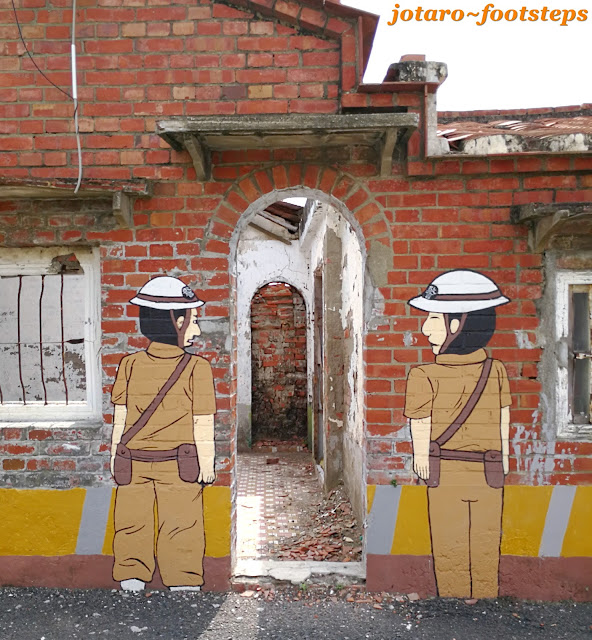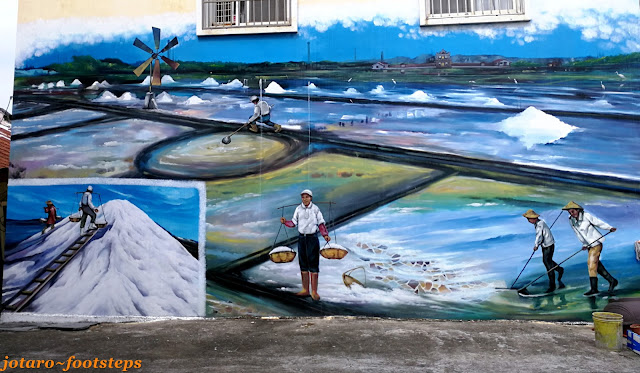You are at - Jotaro's Blog / Footsteps-Cycling Taiwan 2017 / Art Gallery-Sites / Taiwan Art / Yangtian Painted Village (鹽田社區彩繪巷) @ Kaoshiung
Yantian (鹽田), Yong'an District, Kaohsiung City, Taiwan - October 2017
Footsteps - Jotaro's Travels
Yangtian Painted Village (鹽田社區彩繪巷) @ Kaoshiung
On a cycling tour of Taiwan en-route from Tainan (臺南市) to Kaohsiung (高雄市) we visited this unique village where houses were painted with scenes gone-by days of traditional salt farming. This is Yantian (鹽田) village, a village that once had a thriving salt industry; one where salt was manually farmed from the sea onto salt pans. In fact the village name Yantian in Chinese is 鹽田 translates as "salt pans".
About 30 years ago, a power company bought the salt pans to build a power plant, closing the once lively salt town in the process. With their livelihoods gone, may of the townspeople moved out, leaving just over 100 people in the community. To promote this former salt- producing community as a cultural tourism destination, the local district office together with a local non-governmental organization invited students and staff from the Tungfang Design Institute to help decorate old houses with artwork.
Most of the artwork were painted onto the exposed red-bricked walls of many of the vacated houses located at Xinxing Road (新興街) and also along some of the roads branching of from there. Some too were are painted onto the walls of newer occupied houses. The paintings depict an era of days gone by, one of a thriving town with workers in conical padi hats manually harvesting salt from the sea. There are also scenes of the rustic life of the rural people, taking life at a serene, slow pace; ones of playing physical games (so much better than pc games these days), going fishing and street markets. Below are the artwork, many of which are in simple yet amusing cartoon-ish style. Enjoy!
Kung fu time, young apprentice learning the use of curled knives from old shifus.
A salt worker toting salt on rattan baskets while another uses it as a "hat".
Children paying "catch".
A simple life of just sitting around and eating ice-cream and other traditional snacks.
Policemen in period khaki uniforms guarding the delivery of salt. Were salt theft rampant those days?
Young boys playing marbles.
Young boys playing some rural games.
A police man chasing after an absconding salt worker.
Break time at the salt mine with workers eating their packed lunches and taking time off to play with their children.
I like this one showing a couple of policemen in period uniforms guarding an arch entrance.
Workers wearing conical padi hats spreading out salt on pans to dry out.
Workers totting heavy loads of salt from the salt pans.
Close up of above, showing a young boy carrying a kettle of tea. A worker shouts at others ensuring that they move quickly.
Scenes of a rural life, one of simple catapult games and going fishing.
Village street market scene.
Another view of the village street market.
Mining for salt at the salt pans.
Some of the painting are just small caricatures which seems to blend naturally in.
Marching policemen in period khaki uniforms and white pith hats.
Life those days were not easy, children and even babies were brought along to the work place.
Flying cranes common to this locality are often shown in the paintings.
Another view of the long "crane" mural.
Children stressing out a sweet meat seller!
A long mural at a traditional salt mine seen at Yongda road.
Riverside scene with cranes and giant crabs.
A perspective view of the artwork showing how well they fit into the old houses, framing doorways and windows.
Another river scene; showing worker minding the irrigation sluice gates and a young boy carrying a kettle. The elaborate roof of a temple is in the background. It's a fairly new temple.
Many of the houses still retain the old Chinese saddle-style roof. This one with red painted doorway and post seems to leap out from the past.
More views of the salt mine.
Even the walls of bathrooms are not spared!
Young boys and their dog peeping through a window of a barber giving a haircut while another man waits his turn slowing having a hot drink.
Another view of the kung fu school scene.
A policeman and his dog chasing after a thief who probably have robbed the salt mine's payroll.
Locals wearing conical padi hats pedaling on a wooden step irrigator... the job is monotonous and a worker falls asleep!
A young boy enjoying a drink. Above him is a cute green post box.
Most of the artwork a done in simple style; the following painting are done in more realistic style showing the salt mines:
The only surviving shop at the village, a grocery shop called a gamadiam (柑仔店) in local Hoklo language. There we met the oldest resident of the village; he's over ninety years old.
Inside, the old lady operating the shop relaxes on a rattan chair. Eventhough it's a Sunday, life is slow here. Although we found it interesting and eye-catching, and an educational historical place, Yantian is still not that well publicized yet.
Other than another visiting couple, we had the whole place to ourselves and took advantage for lovely poses with the murals and houses.
Siah, sitting cooling "playing" a board game with the locals!
At the gamadiam before we say goodbye to this lovely painted village.
About 30 years ago, a power company bought the salt pans to build a power plant, closing the once lively salt town in the process. With their livelihoods gone, may of the townspeople moved out, leaving just over 100 people in the community. To promote this former salt- producing community as a cultural tourism destination, the local district office together with a local non-governmental organization invited students and staff from the Tungfang Design Institute to help decorate old houses with artwork.
Most of the artwork were painted onto the exposed red-bricked walls of many of the vacated houses located at Xinxing Road (新興街) and also along some of the roads branching of from there. Some too were are painted onto the walls of newer occupied houses. The paintings depict an era of days gone by, one of a thriving town with workers in conical padi hats manually harvesting salt from the sea. There are also scenes of the rustic life of the rural people, taking life at a serene, slow pace; ones of playing physical games (so much better than pc games these days), going fishing and street markets. Below are the artwork, many of which are in simple yet amusing cartoon-ish style. Enjoy!
Kung fu time, young apprentice learning the use of curled knives from old shifus.
A salt worker toting salt on rattan baskets while another uses it as a "hat".
Children paying "catch".
A simple life of just sitting around and eating ice-cream and other traditional snacks.
Policemen in period khaki uniforms guarding the delivery of salt. Were salt theft rampant those days?
Young boys playing marbles.
Young boys playing some rural games.
A police man chasing after an absconding salt worker.
Break time at the salt mine with workers eating their packed lunches and taking time off to play with their children.
I like this one showing a couple of policemen in period uniforms guarding an arch entrance.
Workers wearing conical padi hats spreading out salt on pans to dry out.
Workers totting heavy loads of salt from the salt pans.
Close up of above, showing a young boy carrying a kettle of tea. A worker shouts at others ensuring that they move quickly.
Scenes of a rural life, one of simple catapult games and going fishing.
Village street market scene.
Another view of the village street market.
Mining for salt at the salt pans.
Some of the painting are just small caricatures which seems to blend naturally in.
Marching policemen in period khaki uniforms and white pith hats.
Life those days were not easy, children and even babies were brought along to the work place.
Flying cranes common to this locality are often shown in the paintings.
Another view of the long "crane" mural.
Children stressing out a sweet meat seller!
A long mural at a traditional salt mine seen at Yongda road.
Riverside scene with cranes and giant crabs.
A perspective view of the artwork showing how well they fit into the old houses, framing doorways and windows.
Another river scene; showing worker minding the irrigation sluice gates and a young boy carrying a kettle. The elaborate roof of a temple is in the background. It's a fairly new temple.
Many of the houses still retain the old Chinese saddle-style roof. This one with red painted doorway and post seems to leap out from the past.
More views of the salt mine.
Even the walls of bathrooms are not spared!
Young boys and their dog peeping through a window of a barber giving a haircut while another man waits his turn slowing having a hot drink.
Another view of the kung fu school scene.
A policeman and his dog chasing after a thief who probably have robbed the salt mine's payroll.
Locals wearing conical padi hats pedaling on a wooden step irrigator... the job is monotonous and a worker falls asleep!
A young boy enjoying a drink. Above him is a cute green post box.
Most of the artwork a done in simple style; the following painting are done in more realistic style showing the salt mines:
The only surviving shop at the village, a grocery shop called a gamadiam (柑仔店) in local Hoklo language. There we met the oldest resident of the village; he's over ninety years old.
Inside, the old lady operating the shop relaxes on a rattan chair. Eventhough it's a Sunday, life is slow here. Although we found it interesting and eye-catching, and an educational historical place, Yantian is still not that well publicized yet.
Other than another visiting couple, we had the whole place to ourselves and took advantage for lovely poses with the murals and houses.
Siah, sitting cooling "playing" a board game with the locals!
At the gamadiam before we say goodbye to this lovely painted village.
Yangtian Painted Village (鹽田社區彩繪巷)
Xinxing Road (新興街), Yong'an District, Kaohsiung City, Taiwan 828.
Opens 24 hours | Entry fee: Free
Web news: Kaohsiung borough revives salty past
GPS: 22.83375, 120.20907
(Click here for Google Street View)
Xinxing Road (新興街), Yong'an District, Kaohsiung City, Taiwan 828.
Opens 24 hours | Entry fee: Free
Web news: Kaohsiung borough revives salty past
GPS: 22.83375, 120.20907
(Click here for Google Street View)
Related / Similar Blogs :
You are at - Jotaro's Blog / Footsteps-Cycling Taiwan 2017 / Art Gallery-Sites / Taiwan Art / Yangtian Painted Village (鹽田社區彩繪巷) @ Kaoshiung
If you like this, view my other blogs at Jotaro's Blog
(comments most welcomed below. if you like this pls share via Facebook or Twitter)
(comments most welcomed below. if you like this pls share via Facebook or Twitter)



































































No comments:
Post a Comment